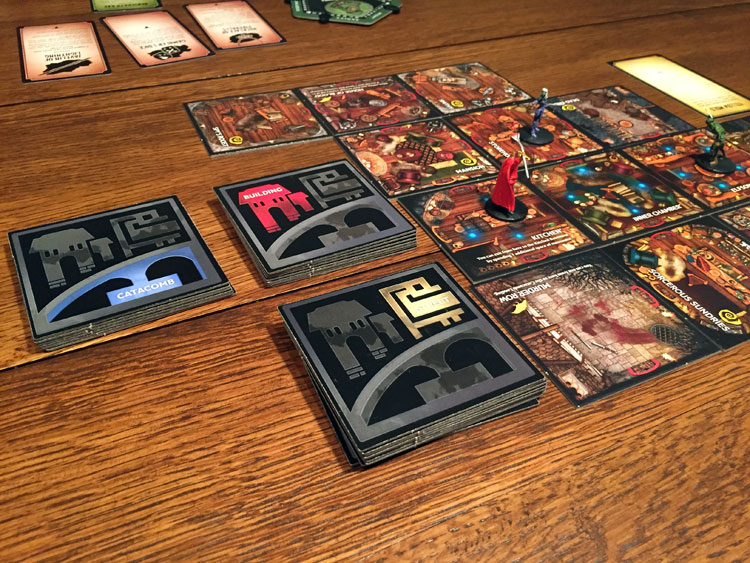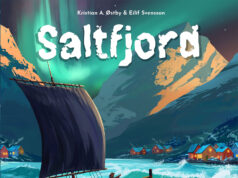 Betrayal at House on the Hill (BHH) has been a cult favorite board game of mine going back to the first edition in 2004. This was the first horror-themed board game I had ever played and the exploration and cooperative mechanic is what I gravitate to. In 2010 BHH Second Edition was released and it was essentially the original version but now with errata fixes incorporated. Last year, the BHH Widow’s Walk Expansion was released which added more tiles, haunts, and game content which this oldie but goodie needed to get back to my gaming table.
Betrayal at House on the Hill (BHH) has been a cult favorite board game of mine going back to the first edition in 2004. This was the first horror-themed board game I had ever played and the exploration and cooperative mechanic is what I gravitate to. In 2010 BHH Second Edition was released and it was essentially the original version but now with errata fixes incorporated. Last year, the BHH Widow’s Walk Expansion was released which added more tiles, haunts, and game content which this oldie but goodie needed to get back to my gaming table.
This brings us to Betrayal at Baldur’s Gate (BBG) from Avalon Hill and WOTC. This exploration, cooperative game incorporates three elements: the D&D universe, the popular D&D city of the Baldur’s Gate, and essentially the game mechanics of BHH. Will Betrayal at Baldur’s Gate become a new cult favorite or does it need to be sacrificed? Read on!
Betrayal at Baldur’s Gate is a cooperative, exploration game for 3-6 players which plays in about 60 minutes and is best with 4-6 players.
Gameplay Overview:
If you’re familiar with BHH and the Baldur’s Gate video game then the BBG theme will be nothing new. The shadow of Bhaal falls over Baldur’s gate and adventurers set-out to defeat the evil, but one may be a traitor.

I think most gamers have played BHH at least once and should be familiar with the rules so I’m going to do an overview and focus on the changes. Here’s the PDF of the rules if you want to see for yourself.
Players select from 12 pre-generated adventurers to play and all start on the Elfsong Tavern tile. Players then each take turns drawing tiles from the two City levels while exploring. If the tile has an Event, Item, or Omen symbol, they stop their movement and draw and resolve the matching card.
Play continues until, at a random point, the Haunt is triggered. One player will become the traitor trying to defeat the other adventurers to win. The other adventurers will try to foil the traitor and survive to win.
Now that’s out of the way, I want to highlight the big changes for this edition of the game.
- First Player: Each player is given a randomly numbered player aid and whoever has the lowest number is the first player.
- Haunt Roll: You will now roll dice equal to the number of revealed Omen cards and if you roll 6+, the Haunt will begin.
- Adventurer’s Power: Each adventurer has a unique power – familiar ones to D&D and Baldur’s Gate fans like Flurry of Blows, Eldritch Blast, & Magic Missile.
- City Levels: There are only two levels: City and Catacomb. The City level is made up Building and Street tiles and Catacomb is made of Catacomb tiles. Some Street tiles include sewer grates that allow one-way movement to the Catacomb level.
- Stealing: During the Haunt, an adventurer can steal an item or omen if they would deal 2 or more points to their opponent.

Game Experience:
I’m going to be honest, I was very excited to play this game because it touches many of my gaming interests over the years. As I mentioned in the beginning, BHH is a cult favorite of mine, I’ve played D&D since I was 10, and have played many Baldur’s Gate RPGs on computer and game consoles since high school.

I will admit that the horror theme I loved about BHH is gone, but it’s been replaced with the fantasy elements from D&D and Baldur’s Gate. Both fit well with Betrayal at Baldur’s Gate and it now feels more like a dungeon crawl, which is not a bad thing. Plus, if you’re familiar with the BHH rules, then it should be easy to get this to the table quickly.
The fantasy element also brings me to one of the big positives in BBG, the adventurer powers. These add variety and replay value to the game that BHH was missing. With the different adventurer powers, I really want to try out all 12 and see how they play, good or bad.
I would warn you that most adventurer powers only come into play during the Haunt because that’s when combat occurs, and a few of the adventurer powers seem lackluster. One, in particular, is Hunter’s Mark. This one can be a big disappointment because if you don’t find, trade, or steal a ranged item or omen weapon, it seems underpowered.

Another positive aspect is the strong Dungeons and Dragons ties to the game. Certain Powers, Items, Events, Omens, and even Haunts are oozing with classic D&D references like Ravenloft, Deck of Many Things, and the 10 Foot Pole. I’ve played BBG 7 times and the D&D nostalgia has yet to waiver for me.
Betrayal at Baldur’s Gate comes with a total of 50 Haunts of varying quality, with some being pretty disappointing. I’m not going to spoil too many for you, but in a few cases the Haunt begins and all adventurers fight a Troll or Umber Hulk and that’s it; no traitor, no traitor rules. Now, from a fantasy dungeon crawl perspective, that’s what you would expect. But from a Betrayal game, you want a little bit more.
Final Thoughts:
I honestly don’t know if Betrayal at Baldur’s Gate will replace my copy of Betrayal at House on the Hill, but I have enjoyed my plays. I will most likely keep both in my collection. Like me, most of my gaming group loves the addition of the powers (even some of the boring ones) and the changes to Betrayal at Baldur’s Gate are light enough for most to master quickly, so teaching the game is minimal. Plus, as a massive D&D fan, the nostalgia factor alone is worth the shelf space.
Final Score: 4 Stars – A fun cooperative, exploration game that’s fast and easy to learn & filled with D&D nostalgia.
 Hits:
Hits:
• Adventurer powers
• D&D theme works well
• Fast and easy to learn
• High replay value
Misses:
• Few powers seem underpowered
• Some Haunts are lackluster
























Nice write up. I find the rules terrible and convoluted. And in the troll haunt you list above, they even make a major typo by not finishing their sentence with the actual number needed to be rolled to find fire. Absolutely zero quality control on the rules and haunt books for this game. Wording is awkward and confusing at many points.
Also, they need to show doors and sewers more clearly. And if you take the one way sewer, where does it lead?!